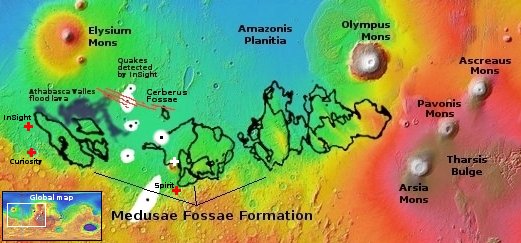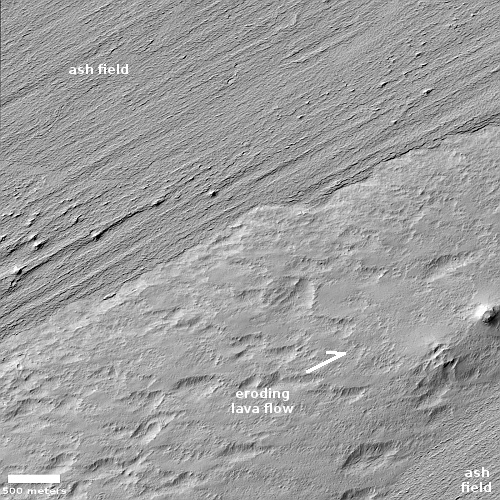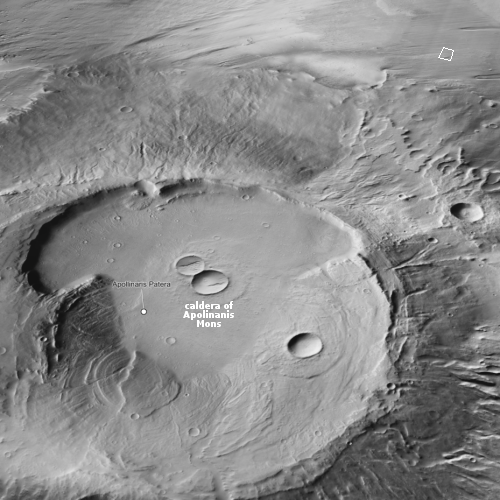A Martian volcanic ash field covering an ancient lava flow
Cool image time! The picture to the right, rotated, cropped, reduced, and sharpened to post here, was taken on April 16, 2023 by the high resolution camera on Mars Reconnaissance Orbiter (MRO). It shows in the center an ancient tongue of lava flow that is surrounded by thick dust fields on the north and the south.
The arrow indicates the downhill grade. It also shows the direction of the prevailing winds, downhill to sculpt the volcanic ash into long streamers of parallel grooves, with obvious eddies forming around bits of older lava that still stick up through the ash. On the lava flow can also be seen one small volcano cone, on the picture’s right edge, suggesting that either during this flow or after it hardened magma bubbled up from below.
The location is fascinating, and in fact puts this picture into its much more spectacular context.

The white cross on the overview map to the right, about 350 miles due north of the landing site of the rover Spirit, marks the location of the picture above, sitting on the edge of the Medusae Fossae Formation, the largest volcanic ash deposit on Mars that is thought to be the source of most of the planet’s dust.
The tongue of lava is a flow that belched a long time ago from one of Mars’ less well-known smaller volcanoes, Apollinaris Mons. The bottom oblique image to the right is created from a global mosaic produced from all the pictures taken by MRO’s context camera, showing the volcano’s caldera at its peak, with the area of the cool picture above indicated by the small rectangle near the upper right.
This lava flow sits about 50 miles from that caldera, 6,500 feet lower down the mountain. Since Apollinaris is estimated to be about 16,000 feet high, this flow still sits on the volcano’s flanks, about two thirds up from its base. With a diameter of about 180 miles, Apollinaris Mons would be considered a major volcano on Earth. On Mars however it is hardly noticed, dwarfed by the giant shield volcanoes to the east and north, all of which are about three to four times higher and many times wider.
Since the volcano is thought to be between 3 to 3.5 billion years old, this lava flow likely happened first, with the Medusae Fossae ash deposits building up over time to either side. Its eroded surface also suggests that it could very easily be some of the source of material that forms those ash fields.
On Christmas Eve 1968 three Americans became the first humans to visit another world. What they did to celebrate was unexpected and profound, and will be remembered throughout all human history. Genesis: the Story of Apollo 8, Robert Zimmerman's classic history of humanity's first journey to another world, tells that story, and it is now available as both an ebook and an audiobook, both with a foreword by Valerie Anders and a new introduction by Robert Zimmerman.
The print edition can be purchased at Amazon or from any other book seller. If you want an autographed copy the price is $60 for the hardback and $45 for the paperback, plus $8 shipping for each. Go here for purchasing details. The ebook is available everywhere for $5.99 (before discount) at amazon, or direct from my ebook publisher, ebookit. If you buy it from ebookit you don't support the big tech companies and the author gets a bigger cut much sooner.
The audiobook is also available at all these vendors, and is also free with a 30-day trial membership to Audible.
"Not simply about one mission, [Genesis] is also the history of America's quest for the moon... Zimmerman has done a masterful job of tying disparate events together into a solid account of one of America's greatest human triumphs."--San Antonio Express-News
Cool image time! The picture to the right, rotated, cropped, reduced, and sharpened to post here, was taken on April 16, 2023 by the high resolution camera on Mars Reconnaissance Orbiter (MRO). It shows in the center an ancient tongue of lava flow that is surrounded by thick dust fields on the north and the south.
The arrow indicates the downhill grade. It also shows the direction of the prevailing winds, downhill to sculpt the volcanic ash into long streamers of parallel grooves, with obvious eddies forming around bits of older lava that still stick up through the ash. On the lava flow can also be seen one small volcano cone, on the picture’s right edge, suggesting that either during this flow or after it hardened magma bubbled up from below.
The location is fascinating, and in fact puts this picture into its much more spectacular context.

The white cross on the overview map to the right, about 350 miles due north of the landing site of the rover Spirit, marks the location of the picture above, sitting on the edge of the Medusae Fossae Formation, the largest volcanic ash deposit on Mars that is thought to be the source of most of the planet’s dust.
The tongue of lava is a flow that belched a long time ago from one of Mars’ less well-known smaller volcanoes, Apollinaris Mons. The bottom oblique image to the right is created from a global mosaic produced from all the pictures taken by MRO’s context camera, showing the volcano’s caldera at its peak, with the area of the cool picture above indicated by the small rectangle near the upper right.
This lava flow sits about 50 miles from that caldera, 6,500 feet lower down the mountain. Since Apollinaris is estimated to be about 16,000 feet high, this flow still sits on the volcano’s flanks, about two thirds up from its base. With a diameter of about 180 miles, Apollinaris Mons would be considered a major volcano on Earth. On Mars however it is hardly noticed, dwarfed by the giant shield volcanoes to the east and north, all of which are about three to four times higher and many times wider.
Since the volcano is thought to be between 3 to 3.5 billion years old, this lava flow likely happened first, with the Medusae Fossae ash deposits building up over time to either side. Its eroded surface also suggests that it could very easily be some of the source of material that forms those ash fields.
On Christmas Eve 1968 three Americans became the first humans to visit another world. What they did to celebrate was unexpected and profound, and will be remembered throughout all human history. Genesis: the Story of Apollo 8, Robert Zimmerman's classic history of humanity's first journey to another world, tells that story, and it is now available as both an ebook and an audiobook, both with a foreword by Valerie Anders and a new introduction by Robert Zimmerman.
The print edition can be purchased at Amazon or from any other book seller. If you want an autographed copy the price is $60 for the hardback and $45 for the paperback, plus $8 shipping for each. Go here for purchasing details. The ebook is available everywhere for $5.99 (before discount) at amazon, or direct from my ebook publisher, ebookit. If you buy it from ebookit you don't support the big tech companies and the author gets a bigger cut much sooner.
The audiobook is also available at all these vendors, and is also free with a 30-day trial membership to Audible.
"Not simply about one mission, [Genesis] is also the history of America's quest for the moon... Zimmerman has done a masterful job of tying disparate events together into a solid account of one of America's greatest human triumphs."--San Antonio Express-News



